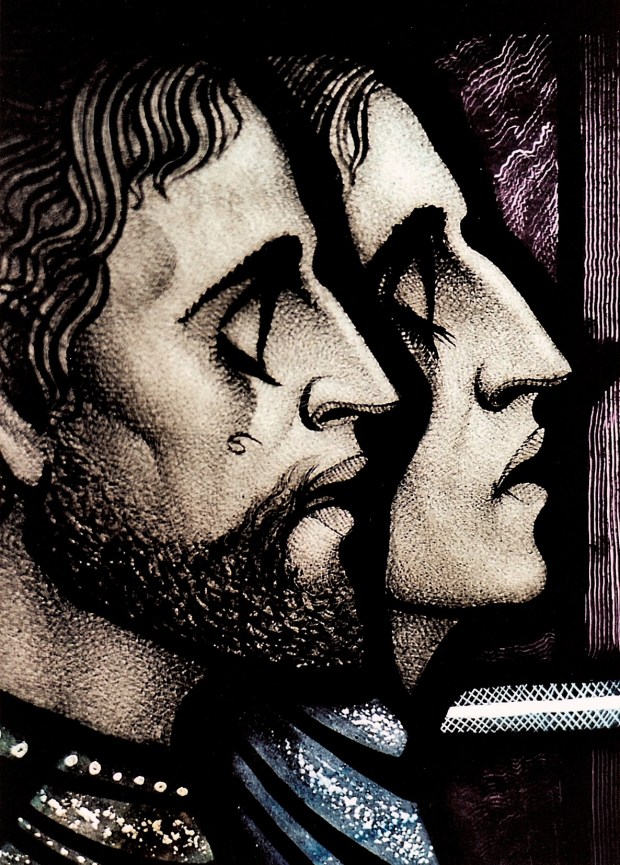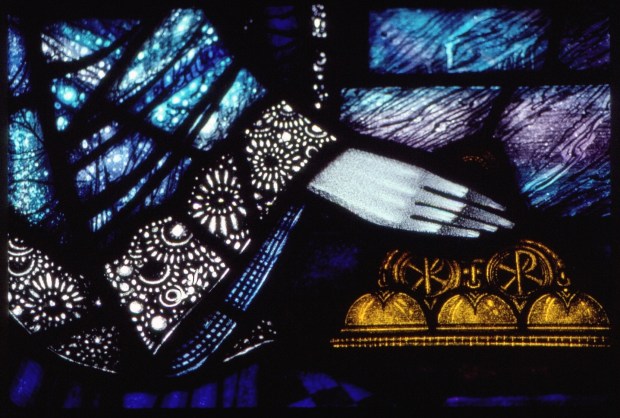Lenten Campaign 2025
This content is free of charge, as are all our articles.
Support us with a donation that is tax-deductible and enable us to continue to reach millions of readers.
We all know what is meant when we hear the word “genius.” For many people, Einstein comes to mind when the word is uttered. Or maybe a stand-out student. Or perhaps the tech guy at the Apple Store.
But there’s another, less common, sense of the word “genius,” which indicates a thing’s peculiar characteristic or spirit.
Most likely, that is what Fr. Joseph Dolan had in mind when he came up with the title “The Genius of the Mass” for the new stained glass windows in his church in Bayonne, New Jersey.
The windows, designed by a renowned early 20th-century Irish artist, are hidden gems known to few beyond the parish. But just as their rich content have helped catechize generations of parishioners, the “Mass in Glass,” as the series of window series is also known, may very well be of increasing interest to pilgrims during the next few years, as American Catholics participate in a national Eucharistic Revival.

Dublin-based stained glass artist Harry Clarke designed the windows for St. Vincent de Paul Church in Bayonne, New Jersey, and he executed the first few panels. But he never saw his work in the church itself, dying of tuberculosis in the midst of the project at age 41. No other church in the US has Harry Clarke windows (though a museum in Miami has one), which are noted for their innovative use of rich colors and lifelike characteristics.
The presence of the Clarke windows, some of which are signed by the artist himself, led to St. Vincent de Paul church being placed in 2011 on the New Jersey and National Registers of Historic Places.
Each of the windows in the nave depicts a different aspect of the Mass or a Mass for a special intention: Mass of the Sacred Heart, Mass of Ordination, Mass of First Communion, Mass of the Holy Spirit, Nuptial Mass, etc. Each one -- tall and narrow, to fit in the church’s Lombard-Romanesque style -- is paired with a scene from the Old Testament, depicting some prefigurement or foreshadowing of Christ. Historical figures are shown in each scene.
So, for example, Cardinal James Gibbons, the ninth archbishop of Baltimore, is shown celebrating the Mass of the Holy Souls. A Latin inscription on the side of the altar, “Pro vivis et defunctis,” indicates that he is remembering the faithful departed. The accompanying window depicts a Jewish high priest offering prayers for the dead while looking down on the Altar of Sacrifice in the Temple. A soldier stands watch over two fallen comrades – one of whom is modeled after Harry Clarke himself.

Bayonne
Wedged in amid Newark Bay, the New York City borough of Staten Island, and the upper Bay of New York Harbor, Bayonne is at the end of the peninsula that includes Jersey City and is not far from Manhattan, the Statue of Liberty, and Ellis Island. The area was claimed by the Netherlands after Henry Hudson explored the great river that would eventually bear his name. Priests in the late 1700s came by horse or sleigh to minister to Roman Catholics in the area, and two of those priests are seen in one of the windows in the nave. Irish Catholic laborers came here around 1836.
In the late 19th century, Bayonne became one of the largest centers in the nation for refining crude oil, including Standard Oil of New Jersey.
Between 1890 and 1910, immigration from Ireland and Germany led to a period of great growth, spawning a number of houses of worship. At one time, said local photographer Peter Keenen O’Brien, within 2 1/2 miles “you had eight Catholic parishes. Each ethnic group had their own church.”
The Irish in the “uptown” section, however, were squeezed between two German neighborhoods with churches of their own and thus were not getting sufficient catechesis in their own language. They successfully petitioned the bishop, who then established the parish of St. Vincent de Paul.
Born on St. Patrick’s Day
Meanwhile, a young man from the area named Joseph Dolan was studying for the priesthood in Italy. He took note of the most beautiful examples of art and architecture he saw there, pledging that when he became a pastor one day, he would build a church and incorporate such elements into it.
On visits to his ancestral land of Ireland, Dolan became familiar with the work of Harry Clarke and was so impressed that he vowed, “When I build my church, nobody except Harry Clarke will put the windows in it.”
Dolan was ordained in 1913, and when he became pastor of St. Vincent de Paul in Bayonne, his dream of building a church became a reality. The congregation was outgrowing its modest house of worship and needed a larger space. Fr. Dolan engaged the architectural firm of Maginnis & Walsh, who also designed the Basilica of the National Shrine of the Immaculate Conception in Washington and the high altar, baldachin and bronze doors of St. Patrick’s Cathedral in New York.
He also contacted Clarke.

Born on St. Patrick’s Day in 1889, Henry Patrick Clarke had been a fabric designer and an illustrator for books by Hans Christian Andersen and Edgar Allen Poe before going to work in his family’s church decorating business. He went on to become a leader in the Irish Arts and Crafts movement, with his windows gracing both ecclesiastical and secular buildings throughout Europe.

Work got underway in Bayonne in 1928, and some of the windows – the wheel window over the main entrance and the nine windows in the apse, as well as the 14 clerestory windows – were shipped from Dublin right around the time the Great Depression was starting in October 1929, arriving in New York on December 10. The installation of the wheel window took place just days before Christmas that dark year.
Following Clarke’s death in early 1931 at the age of 41, his wife, Margaret Crilley Clarke, an acclaimed portrait artist, continued working from the master plan and followed the designs left by her husband, according to a booklet written for visitors by O’Brien and parishioner Priscilla Ege. The two were instrumental in getting historic place designation for the church.
The windows for the nave of the church would be completed and installed from 1939-1944, another dark period for the nation and the world. Priests of the parish were offering special Masses for the safe delivery of these windows because Nazi U-boats were sinking freighters as they crossed the Atlantic, Ege and O’Brien write. One window shows how the war hit home, as it includes an image of a young man from the parish who went missing in action during the war.
The authors explained what set Clarke apart:
Clarke developed an extremely individual style in stained glass, which included the use of hydrochloric acid to create pale colors, especially blues; generous ornamentation; lively animated faces; brilliant coloring especially in ecclesiastical garments; use of the Art Moderne style such as stylized hands, hair and high-necked collars of ruched material; menacing Poe-like faces and figures; the working of lead caming (joining strips) into the design; the the use of floral ornaments of stylized flower heads which are considered “unexpected gems.”

“Harry actually breathed new life into the stained glass industry,” Ege, who is a historian for the City of Bayonne, said in an interview. “He had a flare for the material and then he actually used that flare that he had when he created stained glass windows. So when you look at our windows you see the fold in the material. You see just absolutely the most beautiful vestments and garments that you’ve ever seen in stained glass windows anywhere. ... He had very good taste and he studied very hard to make sure that every vestment that he put in the window in St. Vincent’s -- and I'm sure every window that he created -- was correct and perfect.”
She added that when one looks at St. Vincent’s windows “you see colors that you've never seen before in a stained glass window. It's like going to a museum.”
Ege said she sees similarities in the illustrations Clarke did for the Hans Christian Andersen and Edgar Allen Poe books. “Harry had a light side, and Harry had a dark side,” she said, remarking that his illustration of St. Vincent de Paul on a slave ship has a very Poe-ish feel to it.
O’Brien pointed out that many of the figures in the windows are “very tall, thin, and gaunt looking,” and believes his vision may have been influenced by the history of the Great Hunger in Ireland.
Continuing to teach
The windows executed by Clarke — and signed by him – include a series of nine angels in the apse, each holding some instrument or symbol related to the Mass: missal, thurible, candle, stole, tabernacle, ciborium, chalice, crucifix and cruets.

Today, St. Vincent’s is no longer a predominantly Irish parish. Hispanics and Filipinos are the major groups of worshipers. For those paying attention, the windows still mean a lot to people, “because we're still saying the same Masses” as the ones depicted, Ege said.
“It hasn't changed, you know. When they look at the window they can still see the Mass that's going on in the church at the time like the Corpus Christi Mass or maybe the wedding ceremony,” she said. “Whatever is taking place in the church, it is in those windows.”

It is part of what Fr. Dolan might have had called the Genius of the Mass.










